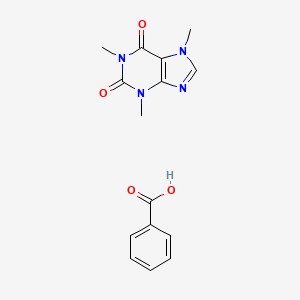
Caffeine benzoate
- Click on QUICK INQUIRY to receive a quote from our team of experts.
- With the quality product at a COMPETITIVE price, you can focus more on your research.
Description
Caffeine benzoate, also known as this compound, is a useful research compound. Its molecular formula is C15H16N4O4 and its molecular weight is 316.31 g/mol. The purity is usually 95%.
The exact mass of the compound this compound is unknown and the complexity rating of the compound is unknown. The storage condition is unknown. Please store according to label instructions upon receipt of goods.Use and application categories indicated by third-party sources: Cosmetics -> Skin conditioning. However, this does not mean our product can be used or applied in the same or a similar way.
BenchChem offers high-quality this compound suitable for many research applications. Different packaging options are available to accommodate customers' requirements. Please inquire for more information about this compound including the price, delivery time, and more detailed information at [email protected].
Scientific Research Applications
Dermatological Applications
Caffeine Benzoate as a Sunscreen Agent
This compound has been studied for its potential as a topical agent that enhances UV protection. Research indicates that it significantly inhibits UVB-induced skin damage, including the formation of thymine dimers, which are precursors to skin cancer. In studies involving SKH-1 hairless mice, topical application of this compound resulted in:
- 90% inhibition of UVB-induced thymine dimers.
- Enhanced apoptosis in UVB-irradiated skin, with this compound showing a 2- to 3-fold greater effect compared to caffeine alone .
Tumor Prevention
This compound has demonstrated efficacy in preventing skin tumors induced by UV radiation. In chronic UVB exposure studies, it was found to inhibit tumor formation and reduce tumor size significantly:
- 76% reduction in the total number of skin tumors per mouse with a 6% concentration of this compound.
- 88% decrease in the number of squamous cell carcinomas .
Psychiatric Applications
Augmentation in Electroconvulsive Therapy
Recent studies have explored the use of this compound as an augmentation agent in electroconvulsive therapy (ECT). In a clinical trial involving 71 patients:
- Administration of 500 mg this compound increased seizure duration by an average of 24.1 seconds , enhancing the efficacy of ECT.
- Patients receiving this compound exhibited improved seizure response rates, which is crucial for effective treatment outcomes .
Neurobehavioral Effects
Impact on Adolescent Behavior
Research has also investigated the neurobehavioral effects of this compound when combined with sodium benzoate in adolescent rats. Key findings include:
- Increased motor activity and improved recognition memory associated with sodium benzoate and caffeine co-administration.
- However, adverse effects on working memory were observed at higher doses, indicating potential risks when combined with processed foods containing sodium benzoate .
Data Summary Table
| Application Area | Findings | Concentration/Method |
|---|---|---|
| Dermatology | 90% inhibition of thymine dimers; enhanced apoptosis | Topical application (6% solution) |
| 76% reduction in skin tumors | Chronic UVB exposure studies | |
| Psychiatry | Increased seizure duration by 24.1 seconds during ECT | Intravenous administration (500 mg) |
| Neurobehavioral Effects | Improved motor activity; recognition memory enhancement | Adolescent rat studies |
Case Studies
-
Skin Cancer Prevention Study
- Objective: To evaluate the effectiveness of this compound in preventing UVB-induced skin tumors.
- Results: Significant reductions in both tumor incidence and size were observed with regular topical applications over an extended period.
-
ECT Augmentation Study
- Objective: To assess the impact of this compound on seizure duration during ECT.
- Results: Patients demonstrated increased seizure durations and improved clinical outcomes compared to those not receiving this compound.
Properties
CAS No. |
5743-17-9 |
|---|---|
Molecular Formula |
C15H16N4O4 |
Molecular Weight |
316.31 g/mol |
IUPAC Name |
benzoic acid;1,3,7-trimethylpurine-2,6-dione |
InChI |
InChI=1S/C8H10N4O2.C7H6O2/c1-10-4-9-6-5(10)7(13)12(3)8(14)11(6)2;8-7(9)6-4-2-1-3-5-6/h4H,1-3H3;1-5H,(H,8,9) |
InChI Key |
VXXKVQICUHMECR-UHFFFAOYSA-N |
SMILES |
CN1C=NC2=C1C(=O)N(C(=O)N2C)C.C1=CC=C(C=C1)C(=O)O |
Canonical SMILES |
CN1C=NC2=C1C(=O)N(C(=O)N2C)C.C1=CC=C(C=C1)C(=O)O |
Key on ui other cas no. |
5743-17-9 |
Related CAS |
8000-95-1 (hydrochloride salt) |
Synonyms |
caffeine - sodium benzoate caffeine benzoate caffeine, sodium benzoate drug combination |
Origin of Product |
United States |
Disclaimer and Information on In-Vitro Research Products
Please be aware that all articles and product information presented on BenchChem are intended solely for informational purposes. The products available for purchase on BenchChem are specifically designed for in-vitro studies, which are conducted outside of living organisms. In-vitro studies, derived from the Latin term "in glass," involve experiments performed in controlled laboratory settings using cells or tissues. It is important to note that these products are not categorized as medicines or drugs, and they have not received approval from the FDA for the prevention, treatment, or cure of any medical condition, ailment, or disease. We must emphasize that any form of bodily introduction of these products into humans or animals is strictly prohibited by law. It is essential to adhere to these guidelines to ensure compliance with legal and ethical standards in research and experimentation.
















